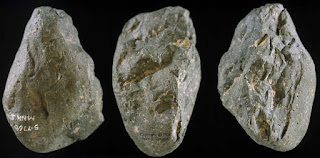Homo Habilis
Note: I started reading Africa: A Biography of the Continent by John Reader. The following posts will basically summarize what I find interesting in the book as I’m reading it. None of the ideas or thoughts are of my own.
The earliest known tools come from sites in Ethiopia and elsewhere in East Africa from 2.4 million years ago (at the latest), and they have only ever been found in association with gracile hominids, not the robust kind (see Part 3: Robust vs. Gracile Australopithecines). The bipedal ancestral hominids existed without the benefit of stone tools for more than a million years and then started making them around the same time that robust australopithecines appeared in the fossil record. There may have been a drastic climatic change or something else that caused some species to specialize, and took others into extinction. For instance, the number of hyena species declined rapidly, which increased the opportunity for hominids to scavenge carcasses and in the process develop tools to break open bones and slice up flesh. Stone tools were also used to process vegetables and nuts.
Stone tools enabled hominids to do with their hands what other animals did with their teeth. These gracile hominids, the earliest toolmakers, came to be known as Homo Habilis, i.e. “handy man”. The Homo Habilis externalized the processing of food while carnivores ripped open carcasses and tore flesh from the bones with their teeth, and as the robust hominids munched on mounds of low-grade plant foods. Furthermore, the brain of the Homo Habilis was appreciably larger than the earlier hominids: gracile or robust. Together, brain size and the capacity to make tools were the accepted definitions of humanity in its true and earliest expression.
However, tools at this point were only used for cutting and cracking food products. Using tools for hunting requires a much higher sophistication. The hominid toolkit remained unchanged for almost a million years, consisting of cobbles with the ends knocked off to make a sharp edge, until around 1.5 million years ago, when the robust became almost extinct, and more than one species of hominid had already evolved into the scene.
 |
| Oldowan tools used during the Lower Paleolithic period |
Bipedalism marks the divergence that led hominids away from the ancestral hominoid stock, but brain size and a more sophisticated toolmaking denote the ancestors of the modern humans.
It was found that robust hominids were present at the same time as Homo Habilis, and the species seem to have shared the expanse of East and southern Africa for several hundred thousand years. Different ways of life minimized the chances of competition and conflict.
Around 1.6 million years ago, Homo Habilis and the robust were joined by a third hominid, Homo Erectus. Homo Habilis disappears from the fossil record shortly after. The robust continued to occupy their specialized vegetarian niche for another half a million years, before they too become extinct at about one million years ago. Homo Erectus was then the sole surviving hominid, and becomes the most widespread and longest-surviving of the known candidates for human ancestry.
The most completed specimen of an ancestral hominid ever unearthed was that of a boy, presumed to be less than twelve years old, whose body became entombed in mud west of the present Lake Turkana about 1.6 million years ago. The Turkana boy was over 1.6m tall, and given the chance to grow to adulthood he would’ve probably reached 1.8m tall. His brain size was approaching 900cc.
 |
| Brain size (cc) vs. Time (millions of years) |
To be continued...

.jpg)













